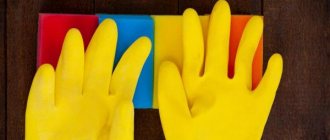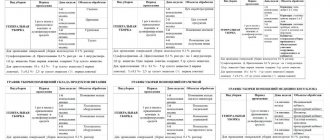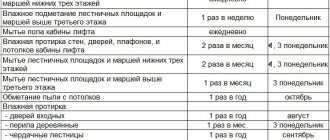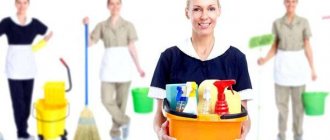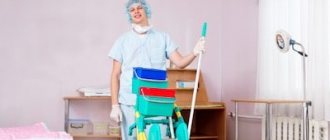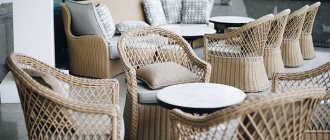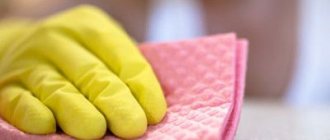01 September 2020
Organizing strict order in the office space, where all conditions have been created for the thoughtful storage of cleaning equipment, disinfectants, detergents, vacuum cleaners, etc., is an excellent basis for professional work. Proper inventory storage allows you to:
- extend its service life;
- make the task easier for the cleaner;
- avoid accidents;
- prevent the spread of infectious diseases;
- organize the most efficient and effective cleaning.
In many organizations, the rules for storing cleaning equipment are determined at the legislative level.
Why do you need labeling of cleaning equipment?
Labeling cleaning equipment according to SanPiN, a sample of which is given in this article, is necessary to prevent cross-contamination of pathogens during cleaning of different areas of the same institution. The marking of equipment for cleaning premises is regulated by a set of Sanitary Rules and Standards.
From January 1, 2022, the Decree of the Chief State Sanitary Doctor of the Russian Federation dated May 18, 2010 No. 58 (as amended on June 10, 2016) “On approval of SanPiN 2.1.3.2630-10” became invalid.
And a new decree of the Chief State Sanitary Doctor of the Russian Federation dated December 24, 2020 No. 44 “On approval of sanitary rules SP 2.1.3678-20 “Sanitary and epidemiological requirements for the operation of premises, buildings, structures, equipment and transport, as well as the conditions of business activities” came into force entities engaged in the sale of goods, performance of work or provision of services" (Registered with the Ministry of Justice of Russia on December 30, 2020 No. 61953).
Chemical-free cleaning cloths
Choosing the right cloth for cleaning without detergents will ensure high quality cleaning and safety for humans and the environment. The product will last for several years and retain its appearance. When purchasing, you should carefully study the instructions on the package. Read the purpose, service life, care instructions.
Top 3 brands for rags
Innovative napkins "Greenway" AQUAmagic. The company produces chemical-free home cleaning products. The base is Japanese cut microfiber.
AQUAmagic universal wipes clean all types of surfaces
- The AQUAmagic SPLITTER double-sided sponge for the kitchen removes stubborn grease from the oven and microwave from stuck fat.
- Universal wipes can absorb unpleasant odors. Quickly remove stains from clothes. Clean the outside of shoes from street dirt. The napkin is moistened and placed in the boots overnight; freshness and cleanliness are guaranteed in the morning. They will save upholstered furniture if it has been “marked” by a pet or something has been spilled.
- The AQUAmagic “Baby” baby care set allows you to clean and massage your child’s body without chemicals. Wipes ensure the cleanliness of toys, children's dishes, and furniture in the child's room.
- The set for car enthusiasts consists of a universal napkin, a napkin for glass, a mitten for cleaning seats, and a large napkin for washing the outside of the car. The AQUAmagic “Lux” car towel will wash a dirty car using 5 liters of water.
Napkins and rags made by HomeStar. New on the market. Suitable for wet and dry cleaning.
They are presented in assortment:
- Microfiber cloths make the cleaning process easier and faster thanks to their double-sided terry weaving. Ultra-fine microfibers remove dust and dirt from microcracks. Different types of napkins are sold: universal, for dishes, tiles, furniture, for cleaning the kitchen.
- Wipes containing bamboo remove grease from tiles, furniture, and stoves. The viscose in the composition provides soft care. Does not leave scratches or streaks. Dries quickly. Wash in running water.
- Viscose napkins are designed for any surface. The products are durable thanks to the polypropylene fibers in their composition. Therefore, they can be used with detergents and bleaches.
- Regenerated cellulose sponge wipes have antibacterial properties. Absorbs unpleasant odors. Suitable for cleaning kitchens and bathrooms. Washable in warm running water.
- Floor cloths made of microfiber and viscose.
Bon Home wipe is suitable for cleaning household appliances
Bon Home multifunctional cloth made of bamboo fiber. Cleans all types of surfaces without detergents. Does not generate static electricity.
Washable with water and laundry soap. The product is available in several colors. This allows you, if desired, to use a separate cloth for a specific type of contamination. Convenient sized napkins. They are washed with laundry soap once a week by hand or in a washing machine. The undoubted advantage is the low price. The products are sold in stores in hardware departments, such as Fix Price.
Additional Information! Also popular on the market are cleaning accessories from the Swedish company Smart, mops and microfiber cloths from White cat, Sweden, and PROTEX wipes “Life without chemicals” from Sweden. You can buy chemical-free products made in Russia.
Marking of cleaning equipment at catering establishments
It is not regulated by a clear purpose of colors. Therefore, each enterprise can independently designate its own colors for each zone. For example, red is for cleaning a meat shop, blue is for a fish shop, green is for a vegetable shop, yellow is for a flour shop. Employees often wonder what color equipment is used to clean the distribution area ? – you can use green color, it can also be used for cleaning equipment of bar counters and tables where food is consumed.
Another frequently asked question: is specially marked cleaning equipment required for refrigerated rooms ? – the answer is definitely “Yes!”, for cleaning each group of premises (hot and cold shops, meat and fish shops, flour and confectionery shops, semi-finished products preparation shops, procurement shops, non-refrigerated warehouses, refrigerated chambers, auxiliary premises, sanitary facilities ) allocate separate marked cleaning equipment, in accordance with the requirements of SanPiN 2.3.2.1324-03 “Hygienic requirements for shelf life and storage conditions of food products.”
Storage rules
Use of marked equipment for a specific room.
Storage of SanPin cleaning equipment, disinfectants and detergents in a hospital, dentistry, hostel, school or any medical preventive center must be correct to avoid poisoning with burns, dermatitis and allergic reactions. In addition, this is necessary to avoid penalties from inspection authorities. Three basic storage rules are worth mentioning:
- Containers for washing must have sealed lids;
- When creating formulations, it is necessary to maintain the temperature regime set by the manufacturer;
- All cleaning products must have factory markings.
The use of unlabeled disinfectants is prohibited according to established standards and requirements. This is due to the impossibility of correctly identifying the composition inside the production packaging. In addition, when preparing a sample of the solution, you must create your own labeling and indicate the preparation date and expiration date. It is imperative that a sanitary and epidemiological safety report, a declaration of conformity, and a state registration certificate be attached to each composition.
Equipment should be stored in a dark room, away from patients, and not in the toilet. In this case, all surfaces must be finished with oil paint, plaster or ceramic tiles. The room should have a light and dry structure. It also needs to be cleaned and put in order periodically. In this case, the preparations should not be exposed to direct sunlight. It is strictly prohibited to use the premises for storing food dairy products with drinking water.
Note! To store cleaning and disinfecting compounds, the room is equipped with a refrigeration chamber. The temperature there is maintained at twenty degrees. At the same time, an air conditioning system for the entire room is installed. When using indoor cooling, open storage systems are used. If small-packaged products are located there, then metal types of shelving are used. Large bottles are stored on shelves and accompanied by appropriate posters.
Color coding of cleaning equipment
Very often, workers in various fields are faced with the question of what color rags and cleaning equipment for cleaning bathrooms are coded according to the international cleaning marking system ; the answer to this question is given in the table below.
| Equipment that is used in rooms with a high degree of bacterial contamination (toilets, bathrooms, storage rooms for dirty linen) is marked red. |
| Green color is used to mark equipment that is subject to more stringent cleanliness requirements (operating room, areas for storing, preparing and consuming food, kitchen, bar counter). |
| Blue or cyan color is applied to equipment and inventory used for places with slight contamination (corridor, reception areas, shop windows, lobby, office, hospital ward, resident's room, hotel room, classrooms in schools and preschool institutions). |
| Yellow color is used to mark equipment used for cleaning conditionally dirty premises (gyms, warehouses and utility rooms). |
| Cleaning equipment marked white can be used for cleaning other rooms. |
Go to the cleaning equipment catalog
Cloth
- It is optimal to carry out a wardrobe audit in the following order:
- Tops (shirts, sweaters, etc.);
- Bottoms (skirts, trousers, etc.);
- Clothes that need to be hung on hangers;
- Socks;
- Underwear;
- Bags;
- Accessories (belts, hats, scarves, etc.);
- Special clothing (swimsuits, sportswear, etc.);
- Shoes.
- It is better to fold/hang things of the same category according to the principle from heavy-dark-long to lighter and lighter. For example, things can be sorted by materials such as “wool” and “cotton”. In the drawers, light and light things should be in the front so that your wardrobe makes you happy.
- Use the bag-in-bag method (no more than 1-2 bags in one bag). At the same time, the bag straps should be visible from the outer bag so that you do not forget about them. It is also desirable that the outer and inner bags are similar in material, season and/or style. Thanks to this trick, you will save space and maintain the shape of your accessories.
- Even fold socks and tights into rectangles. Place them all together in a box or drawer in an upright position so you can see each pair. As Marie says, “Treat your socks with respect.”
- Cup bras should be placed carefully next to each other to ensure they maintain their shape. Soft bras should be folded in half and then folded over the straps. Store your bras in a nice basket, like rattan. After all, everything that comes into contact with the body must be kept with special respect.
- If you have a shoe rack, place heavier shoes on the bottom and lighter shoes on top. Then arrange the pairs by color to keep everything organized.
Marking of cleaning equipment (sample)
InventoryPurposeMarkingMarking methodBucket For cleaning toilets UB Oil paint on the outer surface of the bucket Brush, mop For washing floors For floors Marking is applied with oil paint on the handle of the brush or mop handle, if the handle or handle is made of wood, then the burning method is used Burlap For washing bathrooms A red flap A red flap is sewn onto the corner of the burlap Napkins For washing the walls of corridors With green napkin colorsCleaning cloths are used in different colors for each zone. Mops for cleaning floors in a hotel room. Mops are blue or the colored tags are cut off and only the blue label remains. Mops for cleaning can be either in different colors (corresponding to each cleaning zone), or with sewn-on colored labels in four different colors, three of which are cut off and one label of a certain color remainsHow to Store Dishcloths and Floor Cloths (Kitchen and Bathroom)
To maintain cleanliness and comfort in our home, we cannot do without our faithful helpers. A variety of dust cloths, dish or bathroom sponges, floor rags, pipe cleaners and brushes. Such a variety of necessary attributes requires a separate storage location. Previously, rags made from old things that had been used many times were used for cleaning and washing dishes.
They were stored in and under the sink, on or under tables, and in any available space. There was an unpleasant smell, and the appearance left much to be desired. Now the industry produces a wide variety of this equipment.
Preserving it and using it for as long as possible is important for every housewife.
Therefore, today we want to talk about how to store rags, washcloths, brushes, and other cleaning supplies.
Where to store rags
If you have enough space in your home and a closet, this is a great place to store your equipment. If there is no such room, then you can use a niche in the toilet or bathroom. You can attach shelves, hooks, slats, clips in it and lay out and hang cleaning cloths on them. The main thing is that the room is dry, lit and ventilated.
If there is no separate place, then you can store sponges, rags, towels in the room where they are needed. To do this, you can use a variety of devices that can be placed on a surface, hung on a wall, or attached to cabinet doors.
Many housewives use towel dryers or heating radiators for convenience. The most popular places for this are the kitchen or bathroom.
How long to store
The stores offer a large selection of various cleaning materials. Let's get to know them better.
Microfiber cloths. Ideal helpers that are pleasant to the touch and absorb moisture well and remove dirt. Woven cloths are suitable for the kitchen, they are convenient for wiping dust and washing the floor. They can be washed and dried, this increases their service life to one to two years. Non-woven microfiber is universal in cleaning and is perfect for washing glass. If treated with care it will last about a month.
- A synthetic material that has proven itself to be good is latex. The product is harsh to the touch, but when wet, it absorbs moisture amazingly. This material does not wash well and gradually crumbles, so it will last no more than two months.
- Durable and easy to use natural bamboo cloths. They remove dirt and wash well. Such products can be used for up to six months.
- If you don’t like painstaking care of your equipment, then viscose rags are suitable for you. Rolled napkins are quite dense and easy to use. After one use they are thrown away.
- The biggest helpers in cleaning are sponges. They are varied and versatile. The foam base economically distributes detergents. Since the sponge not only washes, but also absorbs particles of food and dirt, bacteria multiply there quickly. It is recommended to change sponges as often as possible.
- Let's not ignore kitchen towels. The materials from which they are made (bamboo, cotton, linen) are durable, and with proper care, they complement the interior with their appearance. Items must be washed and dried frequently. It is recommended to change them every day, or at least once or twice a week, depending on the frequency of use.
Marking of mops according to SanPiN
Should be applied to the handle or handle of the mop. You can, of course, mark with oil paint or a marker, but this is an unreliable and outdated method, since the paint and marker quickly rub off from the surface. Today, handles from ]TTS[/anchor] (TTS) are developed taking into account the requirements of SanPiN and are marked with a cap of a certain color at the end of the handle. Another advantage of such handles is their ergonomics - they are telescopic and adapt to the operator’s height.
Books
- If there are too many books, they can be sorted into subcategories in the following order:
- Fiction;
- Applied books;
- Illustrated, for example, art albums;
- Magazines.
- When sorting out books, do not start reading them, as this almost always delays cleaning.
- By and large, only those books that belong in your “hall of fame” will remain in your home. For example, Marie herself keeps only 30 books in her house, although she previously had a large library.
- According to Kondo, unread books will never be read. They also tend to accumulate. Therefore, you need to get rid of them.
Cleaning equipment for medical institutions
Carts, mops, containers, rags, mops must be clearly marked or color-coded taking into account the functional purpose of the premises and types of cleaning work and must be stored in a designated area. The rags are marked as follows: rags for cleaning in staff rooms and wards are marked in blue; red - for cleaning bathrooms; green – dressing rooms, treatment rooms; yellow – utility rooms.
A color coding scheme for cleaning equipment in medical institutions should be located in the equipment storage area.
Toilet cleaning equipment must be color coded to indicate special attention. Cleaning equipment for the toilet: rags, buckets, brushes are labeled and stored separately from other cleaning equipment.
Equipment for cleaning toilets must be clearly marked in red, which is used in areas with a high degree of bacterial contamination. In the specialized literature there is often a definition that cleaning equipment for cleaning bathrooms must have a signal marking .
Should cleaning equipment for production, utility and auxiliary premises be marked with paint ? – the answer to this question is definitely “Yes!” Also, such cleaning equipment should be stored in separate rooms equipped with special washing baths ( washing equipment ) and drainage devices with hot and cold water supply, as well as a register for drying cleaning equipment.
Documentation
- Store documents by dividing them into just two categories: those that need to be kept and those that need to be dealt with. The last category includes letters that require a response, questionnaire documents, etc. It is better to store these papers in a separate vertical organizer. At the same time, you need to try to keep it... empty. Its fullness will mean that your affairs are not being solved very productively. The first category of documents is most conveniently divided into rarely used (warranty cards, policies, etc.) and frequently used (for example, current educational materials).
- Organizers with too many compartments make it difficult to sort and find the documents you need. For example, you shouldn't use accordion folders.
List of cleaning equipment subject to mandatory marking:
- Buckets
- Buckets on wheels
- Floor rags (rags)
- Mops
- Mops
- Handles
- Brushes
- Broom
- Scoop
- Squeegees for windows and floors
- Scrapers
- Cleaning trolley
- Bucketless cleaning trolley
- Microfiber cloths
- Trash cans
- Cleaners
- Garbage containers
To summarize, color coding helps:
– avoid cross-contamination and contamination with microbes and bacteria. The reputation of each establishment in the HoReCa sector is very expensive, therefore, in the fight for your client, you must take all possible precautions. And the healthcare, public nutrition and education systems need this vitally.
– marking of cleaning equipment allows you to determine which contamination zone the equipment belongs to, which makes it much easier for management to monitor compliance with cleanliness standards.
Which manufacturers have the best rags for cleaning the house?
What are the best cleaning cloths? Let's try to answer this question by considering the advantages and disadvantages of companies producing cleaning materials.
Greenway cleaning cloths
Reviews of greenway cleaning cloths are generally very good. This company offers a large selection of both wet wipes and rags. Good home care kits are those that contain various cloths with specific functions.
Pros:
- A large assortment. There are kits for car enthusiasts that are used to clean the interior and body;
- A unique composition, thanks to which the rags absorb moisture many times better than ordinary rags;
- Japanese cleaning rags absorb dirt, soot, and grease using the pump principle without chemicals.
Minuses:
Expensive.
Cleaning rags White cat
The Russian brand has existed for more than 20 years.
Pros:
- Suppliers include companies from Germany, Greece, the Netherlands, Italy, USA, Sweden;
- High quality tool that does not require additional chemicals;
- Durability;
- Wear resistance.
Minuses:
There is an opinion among consumers that after using a rag, dust begins to settle on the furniture faster.
Smart cleaning cloths
The Swedish company Smart offers microfiber rags for cleaning glass, mirrors, etc.
Pros:
- Good for quick cleaning;
- Delicately cleans surfaces without streaks;
- Soft texture;
- Hypoallergenic;
- Long service life.
Minuses:
Expensive.
Vileda cleaning cloths
Spongy and universal rags from this company have excellent reviews from housewives.
Pros:
- Excellent surface polishing;
- Convenient packaging;
- No other detergents needed;
- Does not leave lint.
Minuses:
Some people find that napkins wear out quickly.
Bonhomme cleaning cloths
These Chinese rags are very budget-friendly; some reviews say that they are no worse than professional cleaning rags.
Pros:
- Low price;
- Convenient size;
- They do a good job of cleaning.
Minuses:
- wear out quickly;
- You can't do without detergents.
Freken Bock cleaning cloths
Thanks to affordable prices and quality, the Ukrainian brand has gained trust throughout Russia.
Pros:
- Affordable price;
- Pleasant to the touch;
- Hygroscopicity;
- Durable.
There are no significant disadvantages.
Cleaning cloths Clear Line
This brand, founded in 2005, offers a wide range of rags and cleaning kits.
Pros:
- Great design;
- Price-quality ratio;
- Does a great job cleaning.
There are no significant disadvantages.
Cleania house cleaning cloths
Another good brand that produces cleaning supplies.
Pros:
- Excellent for removing stains;
- Excellent moisture absorption;
- Affordable price.
Minuses:
- The fabric is too thin;
- Quickly loses its properties;
- Doesn't wash well.
Home story cleaning cloths
The home story universal napkins on a roll are very convenient.
Pros:
- For any job from mopping floors to cleaning various surfaces;
- Low price.
Minuses:
Detergent must be used.
Ikea cleaning cloths
Ikea can offer quality products.
Pros:
- Excellent moisture absorption;
- Does not damage the surface;
- Microfiber cloths ideally remove dirt without other chemicals.
Minuses:
Expensive.
